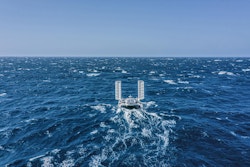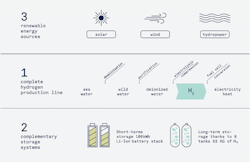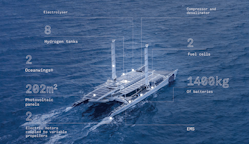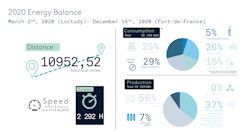Focus on the 10,000 nautical miles of navigation in 2020
In an uncertain global context due to the Covid-19 pandemic, the 2020 program of the Odyssey had been completely revised, and the main stopovers, notably in Tokyo during the Olympic Games or on the Californian coast, postponed.
These events did not prevent our vessel and her crew from continuing its long-distance research missions, the longest since 2017.

More than 10,000 nautical miles in 2020
In 2020, the vessel made the longest sailings in her history with her first transatlantic crossing and the exploration of overseas territories as far as French Guiana, covering more than 10,000 nautical miles. A performance achieved thanks to the total energy autonomy of the onboard systems, an example of resilience that is particularly well suited to the current situation and reassuring for the continuation of the Odyssey.
A reliable energy mix
On board technologies, combining multiple sources -solar, wind and hydropower- and forms of storage, batteries and above all hydrogen, are the forerunners of tomorrow's smart energy grids, which can be reproduced on a large scale, everywhere and for everyone.

Hydrogen, the keystone of the Energy Observer system
While maritime and land mobility meet ever-increasing demands for power, speed and reliability, hydrogen is currently the only energy carrier that offers a credible alternative to fossil fuels without impacting the environment. By testing an energy system based on a mix of renewable energies and hydrogen produced on board this ship, Energy Observer is paving the way for multiple land and maritime applications that can be replicated at the level of a user, a neighbourhood or even an entire city.

The 2020 Energy balance
In 2020, our ship traveled nearly 11,000 nautical miles at an average speed of 4.4 knots. It's still slow, but it's improving year after year. We must not forget that we only consume the energy produced on board! This reminds us on a small scale that we cannot live on energy credit, and that it is more important to go far than to go fast.
In addition, photovoltaics and wind power have taken a significant place in the energy mix this year. This is essentially due to the fact that we sailed in the trade winds where there is a lot of wind and sun. Hydrogen was less useful because we were often at the maximum of our storage capacity, with full tanks. This was not to the displeasure of the crew, who could afford a certain comfort, notably by using the air conditioning.
As far as consumption is concerned, electric propulsion only accounts for a third of our expenses, the rest being distributed between life on board (25%), control and command (26%), servitudes (15%) and the Oceanwings® system (5%).
Energy savings could be made on these electrical consumptions; to be monitored for the future 2021 energy balance!

2020 Energy Balance
A short optimization refit

2020 technical stopover in Martinique
The 5th optimisation refit, which took place in Le Marin, in Martinique, was geared around preparing the boat and her systems for some even longer passages, including Pacific. The first task involved the simplification and optimization of the hydrogen chain using the high-performance REXH2®, developed by EODev in collaboration with Toyota, which proved its worth over a 2020 route that spanned more than 10,000 nautical miles.
Note that the REXH2® fuel cell - compressor – inverter set, installed back in 2019, boasts a maximum power output of 60 kW (though it is operated at around 50% of its potential to optimize its output). Its reduced weight and its compactness, teamed with a level of reliability that has been tried and tested on thousands of cars and heavy goods vehicles, mean that a whole array of new applications can be considered.
All the information about our latest optimization project can be found in our dedicated article.